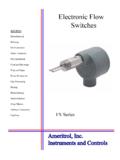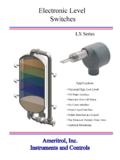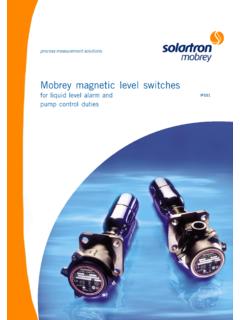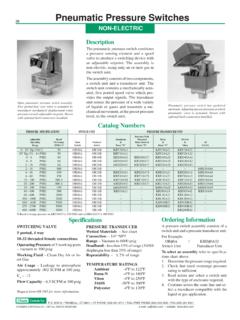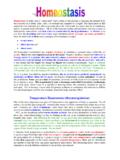Transcription of Rosemount 3144P Temperature Transmitters - …
1 Quick Start Guide 00825-0100-4834, Rev EA. July 2018. Rosemount 3144P Temperature Transmitters with FOUNDATION Fieldbus Protocol Quick Start Guide July 2018. NOTICE. This guide provides basic guidelines for Rosemount 3144P . It does not provide instructions for configuration, diagnostics, maintenance, service, troubleshooting or intrinsically safe ( ) installations. Refer to the Rosemount 3144P Reference Manual for more instruction. The manual and this guide are also available electronically on Explosions could result in death or serious injury. Installation of this transmitter in an explosive environment must be in accordance with the appropriate local, national, and international standards, codes, and practices.
2 Review the approvals section of this manual for any restrictions associated with a safe installation. In an Explosion-proof/Flameproof installation, do not remove the transmitter covers when power is applied to the unit. Process leaks may cause harm or result in death. Install and tighten thermowells or sensors before applying pressure. Do not remove the thermowell while in operation. Electrical shock can result in death or serious injury. Avoid contact with the leads and terminals. High voltage that may be present on leads can cause electrical shock. Contents Mount the transmitter .. 3 Verify transmitter configuration .. 9. Wire and apply power.
3 4 Set the switches .. 10. Verify tagging .. 8 Product Certifications .. 12. 2. July 2018 Quick Start Guide Mount the transmitter Mount the transmitter at a high point in the conduit run to prevent moisture from draining into the transmitter housing. Typical North America installation 1. Mount the thermowell to the process container wall. Install and tighten thermowells. Perform a leak check. 2. Attach any necessary unions, couplings, and extension fittings. Seal the fitting threads with an approved thread sealant, such as silicone or PTFE tape (if required). 3. Screw the sensor into the thermowell or directly into the process (depending on installation requirements).
4 4. Verify all sealing requirements. 5. Attach the transmitter to the thermowell/sensor assembly. Seal all threads with an approved thread sealant, such as silicone or PTFE tape (if required). 6. Install field wiring conduit into the open transmitter conduit entry (for remote mounting) and feed wires into the transmitter housing. 7. Pull the field wiring leads into the terminal side of the housing. 8. Attach the sensor leads to the transmitter sensor terminals (the wiring diagram is located inside the housing cover). 9. Attach and tighten both transmitter covers. A B C. D. E. A. Thermowell D. Conduit for field wiring (dc power).
5 B. Extension (Nipple) E. Extension fitting length C. Union or Coupling Typical European installation 1. Mount the thermowell to the process container wall. Install and tighten thermowells. Perform a leak check. 2. Attach a connection head to the thermowell. 3. Insert sensor into the thermowell and wire the sensor to the connection head (the wiring diagram is located inside the connection head). 4. Mount the transmitter to a 2-in. (50 mm) pipe or a panel using one of the optional mounting bracket. 5. Attach cable glands to the shielded cable running from the connection head to the transmitter conduit entry. 3. Quick Start Guide July 2018.
6 6. Run the shielded cable from the opposite conduit entry on the transmitter back to the control room. 7. Insert shielded cable leads through the cable entries into the connection head/ transmitter . Connect and tighten cable glands. 8. Connect the shielded cable leads to the connection head terminals (located inside the connection head) and to the sensor wiring terminals (located inside the transmitter housing). A D. E. B. C. A. Cable gland B. Shielded cable from sensor to transmitter C. Shielded cable from transmitter to control room D. 2-in. (50 mm) pipe E. B4 mounting bracket Wire and apply power Connect the transmitter to a FOUNDATION Fieldbus network.
7 Two terminators and a power conditioner are required. The voltage at the transmitter terminals must be between 9 and 32 Vdc to operate properly. Power filter A fieldbus segment requires a power conditioner to isolate the power supply and decouple the segment from other segments attached to the same power supply. Power the transmitter 1. Remove the terminal block cover. 2. Connect power to the power terminal. The terminals are polarity insensitive. 3. Tighten the terminal screws. 4. Reattach and tighten the cover. 5. Apply power. 4. July 2018 Quick Start Guide Figure 1. Power the transmitter A. B. C. A. Sensor terminals (1 5).
8 B. Power terminals C. Ground Wiring diagram Figure 2. Rosemount 3144P Single-Sensor 2-wire RTD 3-wire RTD 4-wire RTD T/Cs and RTD with and Ohms and Ohms(1) and Ohms millivolts compensation loop(2). 1. Emerson provides 4-wire sensors for all single-element RTDs. You can use these RTDs in 3-wire configurations by leaving the unneeded leads disconnected and insulated with electrical tape. 2. transmitter must be configured for a 3-wire RTD in order to recognize an RTD with a compensation loop. Figure 3. Rosemount 3144P Dual-Sensor T/Hot T/Hot T/Hot T/Hot T/. Backup/Dual Backup/Dual Backup/Dual Backup/Dual Hot Backup/Dual Sensor with two Sensor with two Sensor with RTDs/ Sensor with RTDs/ Sensor with two RTDs RTDs(1) Thermocouples Thermocouples(1) Thermocouples(1) with compensation Loop(1).
9 1. Emerson provides 4-wire sensors for all single-element RTDs. You can use these RTDs in 3-wire configurations by leaving the unneeded leads disconnected and insulated with electrical tape. 5. Quick Start Guide July 2018. Figure 4. Typical Configuration for FOUNDATION Fieldbus Networking A. B C. E. D. F. H. G. J I. A. 6234 ft. (1900 m) max G. FOUNDATION Fieldbus configuration tool (depending upon cable characteristics) H. Power/signal wiring B. Integrated power conditioner and filter I. Devices 1 through 16. C. Terminators J. The power supply, filter, first terminator, D. Power supply and configuration tool are typically located E.
10 Trunk in the control room. F. Spur Note Each segment in a Fieldbus trunk must be terminated at both ends. Ground the transmitter Ungrounded thermocouple, mV, and RTD/Ohm inputs Each process installation has different requirements for grounding. Use the grounding options recommended by the facility for the specific sensor type, or begin with grounding Option 1 (the most common). Option 1 (recommended for ungrounded transmitter housing). 1. Connect signal wiring shield to the sensor wiring shield. 2. Ensure the two shields are tied together and electrically isolated from the transmitter housing and other grounded fixtures. 3. Ground shield at the power supply end only.










